Dellar warts
Synonyms
Warts, molluscs
Medical: Mollusca contagiosa
definition
Dellwarzen (also: Mollusca contagiosa, mollusks) are harmless skin changes that belong to the group of warts and are caused by a certain virus from the smallpox group, namely the DNA virus Molluscum contagiosum, to be triggered. This type of wart mainly affects children and teenagers and is very contagious.

introduction
The Dellar warts get their name because of their characteristic appearance. Usually the warts impress as about 2-6 mm large, either skin-colored or slightly reddish or whitish nodules with a dent in the middle and often a slightly shiny surface.
In principle, the dellar warts can appear anywhere on the body, but they are often found in the face (often on the Eyelids), at the neck, in the Armpits, at the upper body, to the Hands or, especially in adults, in the Genital region. Dell warts always appear several times, sometimes individually, sometimes in groups distributed over the body. In the indentation of the warts there is a mushy, whitish, sebum-containing content, which many with the virus affected cells and sometimes emptied outwards when pressed.
Transmission of the warts
The Transmission of dellar warts can be done in two different ways:
- One possibility is direct body contact (Contact infection), where the virus is transmitted directly from person to person.
This process is responsible for ensuring that you are also at Sexual intercourse can infect. - The second possibility is the so-called Smear infectionin which the virus is transmitted by touching an intermediate object. This also explains why children often get infected in the swimming pool or in kindergarten, since this is where the Hygiene conditions are often not optimal and for example towels, toy, dress or similar items are shared.
Because of this favorable distribution, it is assumed that between 2 and 8% of the world's population are infected with the virus. After infection, the first warts usually show up after about two weeks to six months.
Who is affected?
In principle, everyone can join in Dellar warts infect. However, there are some groups of people who, due to certain factors, are more likely to become infected.
This particularly includes children (especially because of their not yet so pronounced hygiene behavior), People with Neurodermatitis (because the skin with this disease is very dry and usually already damaged) or People with a reduced immune status (for example through certain diseases such as a HIV-Infection or cancer or by treatment with drugs that do this immune system suppress, such as cortisone).
Symptoms
Often patients are with Dellar warts completely symptom-free, but sometimes there is also one that cannot be neglected itching (especially with already dry skin). In risk groups, the manifestation can be on the skin also sometimes be so pronounced that those affected feel restricted in their quality of life because of this clear external appearance.
diagnosis
Because of their typical appearance, the dellar warts are almost always a visual diagnosis for a doctor. Especially in the early stages, however, it can also happen that the appearance of dellular warts other skin changes, such as common warts (Verrucae vulgares), Genital warts (Condylomata acuminata) or fat deposits (Xanthomas) resemble.
In these rare unclear cases, a tissue sample can be taken and examined under a microscope (histological examination), through which the diagnosis can be finally confirmed and at the same time a malicious change can be excluded.
Also read the article: The viral wart.
therapy

The Therapy of warts is not necessary for all those affected.
The skin changes often resolve spontaneously within six to eighteen months. However, since this regression time sometimes extends over a very long period of time and since there is no guarantee that this regression will take place at all, one often decides to treat the dellular warts after all, especially if they cause symptoms to the patient.
There are several options for treatment.
Most often the warts will be mechanically away. As a rule, they are made using a so-called "sharp spoon"Removed (the corresponding procedure is called curettage). This is a hand surgical instrument that has a spoon-like end with sharp edges that is used to: Tissue growths scrape off.
Also with a curved one in a special way tweezers the warts can be scratched off.
It is also possible to scratch the dellar warts and then squeeze them out with special pliers. It is important that after this process, the skin is thoroughly disinfected so that the Viruses cannot spread over the skin.
All of the above treatments are usually done under local anesthesia, only in exceptional cases (for example in small children or if the skin is affected over a large area) a general anesthetic recommended.
The icing (Cryotherapy). In this form of therapy, one makes freezing techniques (for example with the help of liquid nitrogen, which is around -196 ° C), which have the effect that pathologically altered tissue can be destroyed.
Dell warts can also be removed using a special pulsed dye laser.
Another option is that drug treatment of dellar warts. The patient can usually do this alone. He uses a solution that is diluted Potassium hydroxide (Potassium hydroxide) and or Vitamin A- Contains acid. This preparation has to be dabbed on the warts twice a day, after which they usually go away over time.
Risk of contagion
Dell warts belong to the group of so-called virus warts. For this reason, dellar warts are considered extremely contagious. These skin changes are particularly contagious direct contact or sexual intercourse. However, the responsible viruses can also be transmitted via Smear infection possible. The contagious warts can therefore be transmitted particularly easily if several people same towels and / or items of clothing use. In children, pelvic warts are particularly contagious even when using the same toys.
forecast
The forecast of Dellar warts is generally beneficial: Most of the time they resolve on their own after a certain period of time, but otherwise always go back under appropriate therapy. However, this only applies to a limited extent to patients with a weakened one Immune defense.
In addition, an infection with the Molluscum contagiosum virus (whether with or without therapy) not before a renewed infection, which is why recurrences can often occur in the course of life.
prophylaxis
There are several methods of preventing pelvic wart infestation. Above all there is a general one hygienic behavior, which means you should wash your hands regularly and be sure to use your own towels or clothing.
In addition, you should never touch dellar warts with your bare finger (regardless of whether these are on someone else because you could then become infected, or whether they are on your own body, as you could then spread them to other areas of skin).
It should also be used during sexual intercourse Condoms can be used. Although these do not completely prevent the risk of infection, they reduce the risk significantly.
Dellular warts in children

Dellar warts (Technical term: Mollusks) can be observed in children as well as in adulthood. However, cases of dellar warts are usually found much more common in children. In children, dellar warts typically appear as individual skin-colored or reddish elevations that are usually about the size of a pin. However, especially in children, dellar warts can occur more frequently on a certain body region. The elevations typically have a characteristic, central indentation.
causes
The reason why pelvic warts are particularly common in children is that they are less pronounced Hygiene behavior. The transfer of the responsible virus (Molluscipox virus) is done, for example, by sharing towels or items of clothing. Kindergartens, schools and day-care centers are therefore the ideal transmission sites for pelvic warts. The pathogen also gets in particularly well softened skin areas. Regular visits to swimming pools are therefore a clear risk factor for children.
Even for a child under chronic skin diseases suffers there is an increased risk of developing warts. In addition, an immunostable child is generally considered to be significantly less at risk. Only a few days to months after the virus was able to penetrate the skin barrier do the first warts appear.
diagnosis
The Diagnosis of dellar warts follows the same principles in the child as in the adult. Basically it is a pure one Eye diagnosis. The doctor can only diagnose "dellar warts" by inspecting the affected skin areas. In a child, the most important thing is the face neck, the eyelids, genital area and armpits affected.
Therapy / removal of the wart
In most cases, an immunocompetent child who has warts does not need immediate treatment. In the majority of affected, otherwise healthy, children, the warts form after a few months without medical intervention back (spontaneous healing). However, this long healing time can lead to aesthetic problems. It is not uncommon for the affected child to feel ashamed of the presence of the warts, be teased and, for example, start avoiding swimming pool visits. This can even be true in the long run mental health problems to lead. In addition, the parents of an affected child must be aware that dellar warts highly contagious and a timely removal thus minimizes the risk of transmission.
If rapid therapy is necessary, various methods are available for this. In most cases, pelvic warts develop in the child removed by a dermatologist. In order to make the procedure as painless as possible, the affected skin area can locally anesthetized become. In the child one uses for this purpose numbing skin creams or Gels. Before the actual treatment can begin, the anesthetic must act on the child's skin for at least one hour. In this way, the wart removal is particularly gentle for the child.
After the treatment area has been anesthetized, the surface of the dellar wart is thoroughly disinfected. Then the actual removal of the dellar warts takes place with the help of a sharp spoon or fine tweezers. After removing the warts from the child, it is extremely important to disinfect the affected skin area again. In this way, the viruses that are still present cannot be transferred to other parts of the body and thus promote the development of new warts.
Another treatment method that is particularly suitable for children is Icing of the warts.
The treating dermatologist exposes the wart to liquid nitrogen for a short period of time (Cryotherapy).
When the wart freezes over, the infected tissue dies and from below, healthy tissue grows back. The icing of the wart is usually not particularly uncomfortable for the child or the person affected.
Parents of an affected child can also treat their warts from home. The warts should be treated twice a day with a special potassium hydroxide solution (Potassium hydroxide) must be dabbed off until a noticeable inflammatory reaction occurs. Based on this inflammatory reaction, the pelvic warts in the child usually heal completely.
prevention
Especially with children it is Prevention of warts is extremely difficult. A child is in constant contact with their peers. In addition, children are usually very active, sweat, go to the swimming pool and offer those responsible Viruses thus an ideal entry point into the skin. However, parents should make sure that every child has one own towel and these are not exchanged with one another.
Regular disinfection of the hands can of course reduce the risk of transmission, but transmission cannot be completely ruled out. In addition, care should be taken that a child who already suffers from pelvic warts never touches them with their fingers and then touches other parts of the body or even other children.





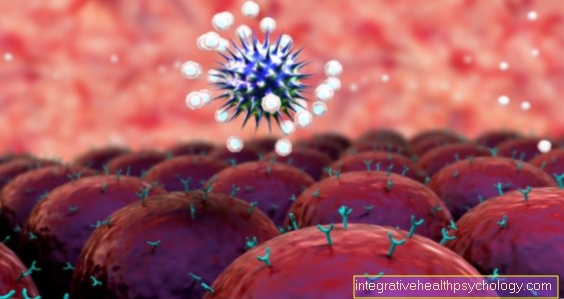






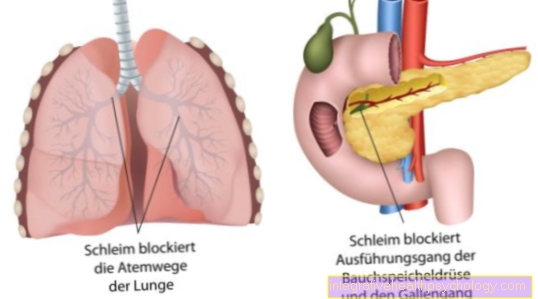



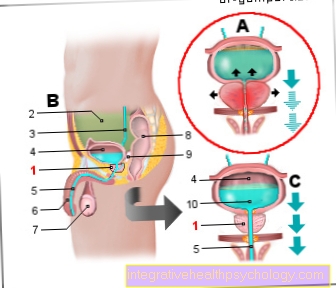
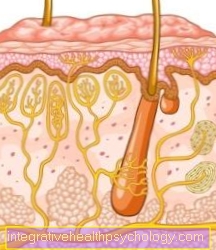
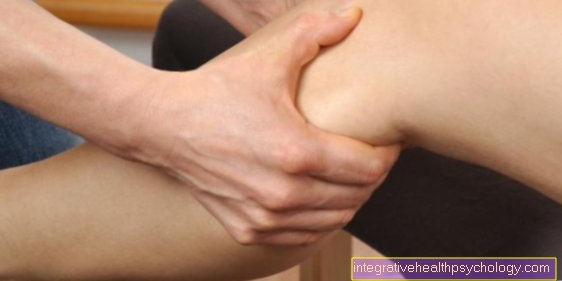

.jpg)








